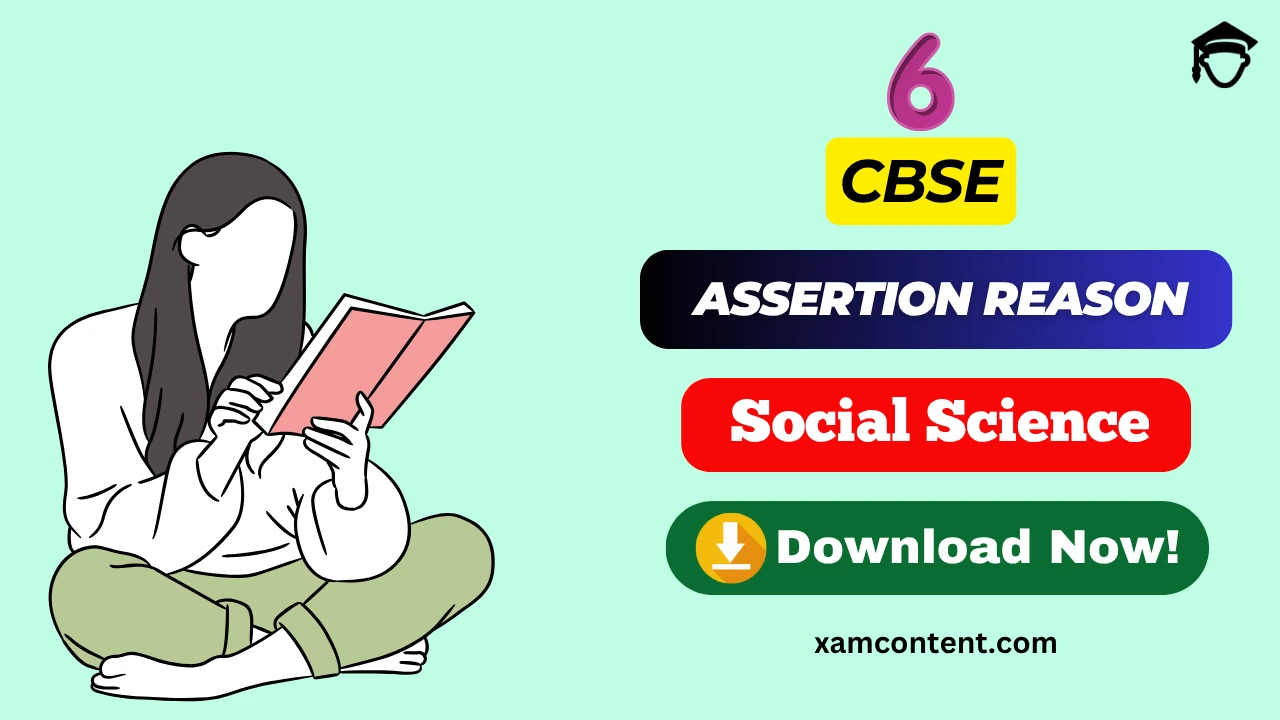Last Updated on November 16, 2025 by XAM CONTENT
Hello students, we are providing assertion reason questions for class 6. Assertion Reason questions are the new question format that is introduced in CBSE board. The resources for assertion reason questions are very less. So, to help students we have created chapterwise assertion reason questions for class 6 Social Science. In this article, you will find assertion reason questions for CBSE Class 6 Social Science Chapter 9 Family and Community. It is a part of Assertion Reason Questions for CBSE Class 6 Social Science Series.
| Chapter | Family and Community |
| Type of Questions | Assertion Reason Questions |
| Nature of Questions | Competency Based Questions |
| Board | CBSE |
| Class | 9 |
| Subject | Social Science |
| Useful for | Class 6 Studying Students |
| Answers provided | Yes |
| Difficulty level | Mentioned |
| Important Link | Class 6 Social Science Chapterwise Assertion Reason |
Assertion Reason Questions on Family and Community
Q1. Assertion (A): The family is the first social unit where children learn values and rules.
Reason (R): It teaches language, sharing, and respect through everyday interactions.
(a) Both A and R are true and R is the correct explanation of A.
(b) Both A and R are true but R is not the correct explanation of A.
(c) A is true but R is false.
(d) A is false but R is true.
Show Answer
Ans: (a)
Explanation: Both statements are true and connected: families transmit basic social values and habits by daily practice and guidance.
Q2. Assertion (A): A nuclear family always includes grandparents.
Reason (R): A nuclear family usually consists of parents and their children living together as a small unit.
(a) Both A and R are true and R is the correct explanation of A.
(b) Both A and R are true but R is not the correct explanation of A.
(c) A is true but R is false.
(d) A is false but R is true.
Show Answer
Ans: (d)
Explanation: The assertion is false—grandparents are not a necessary part of a nuclear family—while the reason correctly defines a nuclear family.
Q3. Assertion (A): The Gram Panchayat implements development works at the village level.
Reason (R): The Sarpanch (head) is elected by all adult residents of the village.
(a) Both A and R are true and R is the correct explanation of A.
(b) Both A and R are true but R is not the correct explanation of A.
(c) A is true but R is false.
(d) A is false but R is true.
Show Answer
Ans: (b)
Explanation: Both statements are true; however, the reason describes leadership selection, not why or how the Panchayat implements development works.
Q4. Assertion (A): A community is only the people living on the same street.
Reason (R): Communities can also be based on shared interests, languages, or occupations across a wider area.
(a) Both A and R are true and R is the correct explanation of A.
(b) Both A and R are true but R is not the correct explanation of A.
(c) A is true but R is false.
(d) A is false but R is true.
Show Answer
Ans: (d)
Explanation: The assertion is false—communities are broader than a single street—while the reason correctly explains that communities can form around many shared features.
Q5. Assertion (A): Social harmony improves safety and cooperation in a neighbourhood.
Reason (R): This happens because members focus only on their personal interests and ignore others’ needs.
(a) Both A and R are true and R is the correct explanation of A.
(b) Both A and R are true but R is not the correct explanation of A.
(c) A is true but R is false.
(d) A is false but R is true.
Show Answer
Ans: (c)
Explanation: The assertion is true, but the reason is false: harmony depends on mutual respect and concern for others, not self-interest.
Q6. Assertion (A): Community helpers like teachers, doctors, and sanitation workers improve overall well-being.
Reason (R): They provide essential services that meet education, health, and cleanliness needs.
(a) Both A and R are true and R is the correct explanation of A.
(b) Both A and R are true but R is not the correct explanation of A.
(c) A is true but R is false.
(d) A is false but R is true.
Show Answer
Ans: (a)
Explanation: Both statements are true and directly linked: these helpers’ services build a healthy, educated, and clean community.
Q7. Assertion (A): Neighbourhood cleanliness drives help reduce disease and improve public health.
Reason (R): Municipal corporations collect property tax from residents.
(a) Both A and R are true and R is the correct explanation of A.
(b) Both A and R are true but R is not the correct explanation of A.
(c) A is true but R is false.
(d) A is false but R is true.
Show Answer
Ans: (b)
Explanation: Both statements are true; however, the reason does not explain why cleanliness drives reduce disease—it is an unrelated administrative fact.
Q8. Assertion (A): Joint families allow members to share resources and responsibilities.
Reason (R): Only adults in joint families share tasks; children do not contribute at all.
(a) Both A and R are true and R is the correct explanation of A.
(b) Both A and R are true but R is not the correct explanation of A.
(c) A is true but R is false.
(d) A is false but R is true.
Show Answer
Ans: (c)
Explanation: The assertion is true, but the reason is false: in many joint families, even children help in age-appropriate ways (e.g., tidying, errands).
We hope the given assertion reason questions with Answers for Family and Community Class 6 helps you in your learning.

Also check
- Class 6 Social Science Assertion Reason Questions Chapter 14 – Economic Activities Around Us
- Class 6 Social Science Assertion Reason Questions Chapter 13 – The Value of Work
- Class 6 Social Science Assertion Reason Questions Chapter 12 – Grassroots Democracy Part 3 Local Government in Urban Areas
- Class 6 Social Science Assertion Reason Questions Chapter 11 – Grassroots Democracy Part 2 Local Government in Rural Areas
- Class 6 Social Science Assertion Reason Questions Chapter 10 – Grassroots Democracy Part 1 Governance
- Class 6 Social Science Assertion Reason Questions Chapter 9 – Family and Community
- Class 6 Social Science Assertion Reason Questions Chapter 8 – Unity in Diversity
- Class 6 Social Science Assertion Reason Questions Chapter 7 – India’s Cultural Roots
- Class 6 Social Science Assertion Reason Questions Chapter 6 – The Beginings of Indian Civilisation
- Class 6 Social Science Assertion Reason Questions Chapter 5 – India, that is Bharat
- Class 6 Social Science Assertion Reason Questions Chapter 4 – Timeline and Sources of History
- Class 6 Social Science Assertion Reason Questions Chapter 3 – Landforms and Life
- Class 6 Social Science Assertion Reason Questions Chapter 2 – Ocean and Continents
- Class 6 Social Science Assertion Reason Questions Chapter 1 – Locating Places on Earth
Topics from which assertion reason questions may be asked
Assertion reason questions from the above given topic may be asked.

You may also like

Frequently Asked Questions (FAQs) on Family and Community Assertion Reason Questions Class 6
Q1: What are Assertion Reason Questions in Class 6 Social Science?
A1: Assertion Reason Questions are a new type of competency-based questions where students are given two statements — an Assertion (A) and a Reason (R). Students must decide whether each statement is true and whether the Reason correctly explains the Assertion.
Q2: How can Assertion Reason Questions help in exam preparation?
A2: These questions help students think critically, understand cause–effect relationships, and go beyond rote learning. They strengthen conceptual clarity in topics like History, Geography, and Civics by testing logical connections between facts.
Q3: How should students approach Assertion Reason Questions?
A3: Students should first read both statements carefully, identify whether each is true or false, and then check if the Reason actually explains the Assertion. Practicing chapter-wise Assertion Reason sets regularly improves accuracy and speed.
Q4: Are Assertion Reason Questions included in CBSE Class 6 syllabus?
A4: While Assertion Reason Questions are not directly mentioned in the NCERT syllabus, they are part of the new competency-based assessment pattern introduced by CBSE to promote conceptual understanding and analytical thinking.
Q5: What types of topics are covered in Class 6 Social Science Assertion Reason Questions?
A5: Topics include key chapters from History (e.g., What, Where, How and When?), Geography (e.g., The Earth in the Solar System), and Civics (e.g., Understanding Diversity) — focusing on reasoning, relationships, and application of knowledge.
Q6: Where can I find Assertion Reason Questions for Class 6 Social Science Chapter-wise?
A6: You can access free, chapter-wise Assertion Reason Questions with detailed explanations at xamcontent.com and physicsgurukul.com. These resources are designed as per the latest CBSE competency-based exam format.
Q7: What is the difference between a joint family and a nuclear family?
A7: A joint family includes several generations living together, while a nuclear family usually consists of parents and their children living independently.
Q8: Why are cousins often considered brothers and sisters in many Indian languages?
A8: Indian family systems emphasise close bonds, so there is often no separate term for ‘cousin’; they are treated as brothers and sisters, reflecting strong relationships.
Q9: What values are learnt within a family?
A9: Children learn love, cooperation, responsibility, discipline, sharing, service (seva), giving (dāna), and sacrifice (tyāga), which shape their character.
Q10: How do family members share responsibilities?
A10: Parents care for children, elders offer guidance, and children help with chores as they grow. Each member contributes to the household’s well-being.
Q11: What is a community?
A11: A community is a group of families connected by shared traditions, activities or resources. Members support each other socially and economically.



